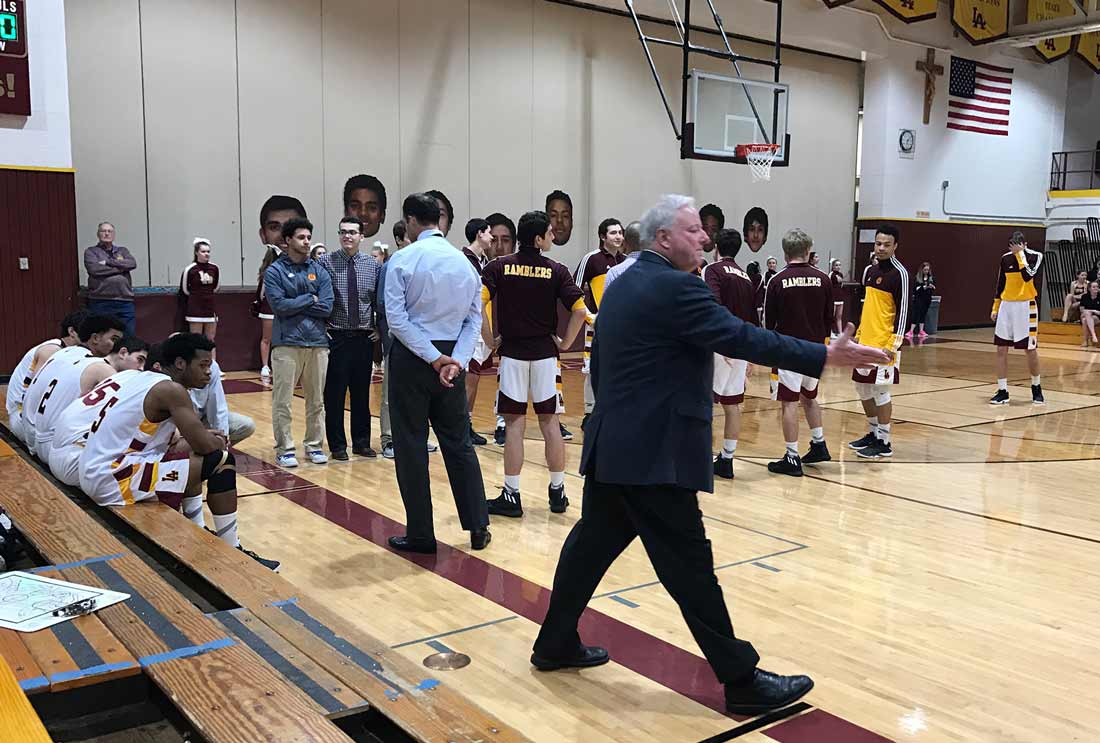By Andres Waters
After Loyola Academy held off rival New Trier 43-40 to win the 2017 Zion-Benton regional championship, Ramblers head coach Tom Livatino had a special message for his players.
“That’s the best celebration that I have ever been a part of,” Livatino said. “Because everybody was completely about love. You guys love each other and we all can tell. I’m really, really proud just to be one of our coaches.”
While the speech was a powerful way for Livatino to tell the players of his appreciation, he and other high school coaches engage in something much bigger to show players how proud they are: college recruiting.
In addition to time spent planning and practicing, coaches also sacrifice countless hours each week helping their players find opportunities to play at the next level.
“It’s a really long part of the process, but to be honest, it’s a part of the job that I absolutely love,” Livatino said. “We demand so much of our players in every aspect. And, from a basketball standpoint, the least I could do is everything in my power to help them out.”
Less than 48 hours after the Ramblers completed their season with a loss to Evanston Township in the Waukegan Sectional semifinal, Livatino was back in his office holding individual meetings with each player.
Starting with the 10 departing seniors, Livatino discussed the factors that go into choosing a college for high school athletes.
His conversations with the two players who already committed, senior guards Ramar Evans and Matt Lynch, focused on how they felt about their next steps. With the others, Livatino asked whether they wanted to play at the next level and, if so, which schools they wanted to attend that shared an interest in them. The conversations held with the Ramblers’ juniors are very similar.
“I wasn’t just looking for basketball, I was looking for a fit academically and socially,” said Lynch, who committed to Division III St. Norbert College. “[Livatino] said St. Norbert would be the best fit for me. It fit everything I was looking for.”
Though this year’s senior class didn’t feature any players who were recruited by Division I teams, Livatino said the process is no different for players who end up playing Division II or Division III.
“It’s equally time-consuming,” he said. “[Coaches] spend just as much time getting their [players’] names out through sending video and information out there to [college] coaches. We’re trying to expand the options for the players.”
Livatino said he’s spent nearly 10 hours per week working on helping his players get recruited this season.
His meetings with Loyola’s sophomores are a little more complex. While the underclassmen are on the freshman, sophomore or junior varsity teams, their coaches evaluate them to see which level they may be able to play at after graduation.
Paul Pryma, a Ramblers assistant coach and former Evanston Township head coach, said when he evaluates players, he primarily looks for three things.
“Shooting, explosive athleticism and competitiveness,” Pryma said. “When you can shoot the ball, it opens up a lot of options. And to compete at that level you’ve got to be so competitive. It’s dog eat dog.”
When evaluating their athletes, coaches must account for both where a player currently stands and his potential. Livatino, who has coached D-I recruits in the past, admits the process is generally expedited for top recruits. However, for the majority of high school players, it begins after their sophomore season.
“Going into their junior year, if these are kids that want to play college basketball or these are kids that we know are going to play, we sit down with those families,” Livatino said. “A lot of times that’s met with resistance, because they might think their son is at a higher level than I see them at.”
While this is not a regular problem at Loyola, other coaches encounter challenges.
“A lot of parents want the coach to do everything they can to get their kids noticed by colleges,” Pryma said. “Well, the bottom line is, if you’re a good high school player the colleges are going to know who you are. And if you’re a really good player and you choose a school that isn’t quite the school that you wanted, you’ll make that school a top school.”
Livatino said when families are upset with a coach’s analysis, it is often their first time hearing realistic expectations for their children.
Meetings with the rising sophomores and incoming freshmen, meanwhile, are mainly about explaining the recruiting process.
“Players start to figure out geographically, where they want to go to school; academically, where they can go to school and; socially, what’s going to be their mix,” Livatino said.
Pryma said finding the right fit for each player is the hardest part of recruiting for high school coaches.
“You’re with these kids all day long [during] the school day, then you’ve got practice, then you’re traveling from game to game.” he said. “[And] you’re intimately associated with their educational process; you know these kids in and out. You’re trying to see how it all funnels in to make a good fit.”
For many high school coaches, the work doesn’t stop after players have moved on to the next level. It is not uncommon for coaches to stay in touch with them and make sure everything is going smoothly.
Livatino said he checks in with his players to make sure they are happy with their decision and how they feel about their new program. He even offers advice to players when they are considering transferring to other programs.
“There is so much that goes into the process of recruiting,” he said. “We [coaches] are doing everything we can to make sure our players find the right fit. Leave no stone unturned.”

